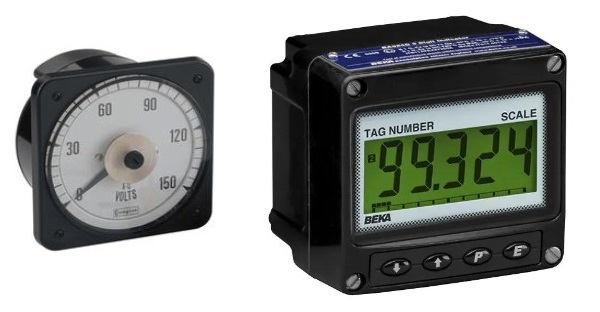Loop Powered Process Displays to Add Easy Measurements
Have you ever needed to know the temperature, pressure, flow, or other measurement on location, but the readout is way off in the control room? Here’s an easy way to add a readout in the field.
Some process transmitters have readout displays, but most don’t. You’d like to add a local display, but that usually means running power to it. You could add an analog 4-20 meter. Easy, except you’d need to find a scale with a custom range, and you couldn’t read it precisely. Below is one example, scaled for 0-150 volts. The solution is to add a digital loop powered display.

Figure 1. Process displays - analog vs. digital. Images used courtesy of Crompton Instruments and BEKA Associates Ltd
Loop Powered Displays - What Are They?
What is a loop powered display? It is simply a digital numeric readout which needs only two wires. It is powered by just the 4 to 20 mA signal and needs no other power source. It requires at least 4 milliamperes; it will not work at zero. You wire the current in series, not parallel. It needs a few volts to operate. Here’s a simple diagram of how to connect it.

Figure 2. Typical 4-20 mA process signal loop, with loop powered display added.
The display does not show 4-20 mA; rather, you scale it to whatever units you need. One display might want to be 0 to 400 pounds, another might need to be offset, such as 50 to 150 kilograms, another could be -50.0 to +75.0 degrees.
How do Loop Powered Displays Work?
The 4-20 mA current flows through the circuit, dropping a few volts as it passes. That is where its power comes from. The 4 mA (or usually a bit less) does the work: anything more is not needed.
The circuit includes analog to digital (A/D) circuitry, a voltage regulator, and whatever else is needed. The details differ among various products. The earliest displays used a 3 ½ digit analog-to-digital converter – usually the ICL7106. I designed one in the 1980s, which I thought would be the first, but another company beat it to them. More recently, a 4 1⁄2 digit version was added, the ICL7135. The ICL7106 is still used: I don’t know if the ICL7135 was ever used for a loop powered display. Most of the newer designs work differently and add other features. The newer designs use microprocessors or microcontrollers.
The operating voltage varies. The lowest is about 3 or 3.5 volts. The highest is about 7 volts, usually because of some extra features.
Installation and Operation
Some manufacturers use the standard 1/8 DIN panel mount design with a 92 x 45 mm cutout. There are several other designs. Some offer explosion-proof or weatherproof (NEMA 4X) enclosures. Most use 7-segment displays.

Figure 3. There are various types of loop powered displays. This one has an explosion-proof enclosure. Image courtesy of the Wilkerson Instrument Company
Most of the earlier products use a combination of multiturn potentiometers and switches in order to adjust the engineering scale of the display. You need to calibrate them while adjusting, usually at 4.0 mA and 20.0mA, while adjusting. Most of those that are based on a 3 ½ display include an extra trailing zero that can be turned on if needed. This allows for higher ranges (for example, 12,500). For low numbers, you can turn on a decimal point.
The newer microcontroller-based designs work differently and might include graphical menus or tactile user interfaces. In any case, once they’re calibrated, they are set unless you change them to a different range.
Installation details depend on the design of the enclosure.
Features and Options
Options include 1/8 DIN rail and explosion-proof options, as already mentioned. There are other types of housings as well.
At least two manufacturers use LED digits instead of LCD. The LEDs need higher voltage.

Figure 4. This loop-powered display uses LEDs, not LCDs. This is a standard 1/8 DIN enclosure. Image courtesy of Seneca Instruments
Some have more features than just the display. First, the more recent displays may be more than 3 ½ digits wide. Second, the display might include things like letters, bar graphs, or other information.

Figure 5. Today’s loop powered displays can have more than 3 ½ digits and might display things like alphanumeric information or bar graphs along with the digits. Image used courtesy of Precision Digital Corporation
Understanding Loop Powered Displays
A loop powered display can make it easy to add a local reading to your system. You need only two low-voltage wires.
Often, the display can be placed right next to the instrument. Other times, perhaps far away. The display’s location might be too high or low, or maybe too hot or cold. If so, you usually can find a nearby location more suitable. There are a variety of styles.
The original loop powered displays used 3 ½ digits, but more recent designs may provide additional resolution or other options.






